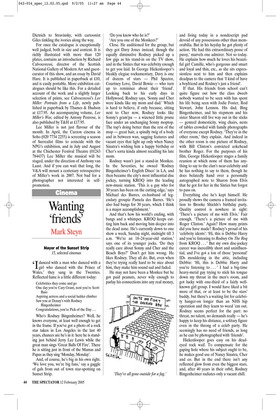Surrealist legend
Andrew Lambirth
Lee Miller: Portraits National Portrait Gallery, until 30 May Sponsored by Herbert Smith The ravishing new exhibition of Lee Miller’s portrait photographs at the NPG is prefaced by a corridor selection of shots of Miller by others — principally by the fashion photographer George Hoyningen-Huene (whose assistant she was on French Vogue in 1930) and her long-standing friend and lover, Life photographer David E. Scherman. Miller (1907–77) was a great beauty who had considerable success as a model before taking to the camera herself. She had first wanted to be a painter, and studied lighting and stage design before travelling to Italy to study art. Edward Steichen, who photographed her, suggested she try photography, and at this point she went to Paris to meet Man Ray. She became his pupil, model, lover, and together they discovered the technique of solarisation (overexposing film — Lee apparently turned the light on in the darkroom when a mouse ran over her foot — to change dramatically its tonality).
Miller had the temerity to set up on her own as a photographer and to throw over Man Ray. For the Surrealist men to behave like this was acceptable, but for their women, their Muses? Unthinkable. And what was perhaps worse was that this revolutionary went on to produce extraordinary and memorable photographs, even though she did her best to suppress them in later years. From the Thirties date some of the earliest images in the exhibition an unrecognisable Charlie Chaplin sporting a candelabra on his head, a predatory Gertrude Lawrence, and the Surrealist box-maker Joseph Cornell, with a model yacht emerging from his coiffure. The selection, of over 100 black-and-white images, has been admirably done, and the installation is both elegant and engaging. This is a joy of an exhibition.
However, the Lee Miller Story has to be separated from Miller’s substantial achievement as a photographer (the archive kept by her son numbers 60,000 negatives), for the legend threatens to swamp the images, and it would be easy to write only about her life. Man Ray, for instance, was driven almost insane with jealousy over Lee’s behaviour. As David Hare points out in his perceptive essay in the catalogue: ‘She was used to being the cause of hysteria in others while essentially remaining calm inside herself.’ (And Mr Hare should know: I gather he has researched and written a screenplay about Miller’s life, though it’s not yet in production.) He goes on: ‘She was certain that, whatever life threw at her, she was protected.’ Hence her fearlessness and devil-maycare bravery in reporting the second world war for Vogue, which included taking the most harrowing photographs when Buchenwald and Dachau were first liberated, and imploring that they were printed.
Miller’s war work is not featured here, the exhibition sticking wisely to the ‘portrait’ remit. By this time, Lee had formed a lasting alliance with the Surrealist artist and writer (I find it odd that Mr Hare refers to him as an art critic) Roland Penrose. Their son, Tony Penrose, said at the press view: ‘If you want to understand Lee’s work, think of her first as a Surrealist.’ It’s certainly true that the lessposed shots tend to work best, though the female impersonator and Carry On star Charles Hawtrey has never looked better than in the feathers and spotted frock he donned for this Vogue shoot. Even when formal, Miller’s portraits are not formalised. See her shot of the infamous Moura Budberg, mistress of H.G. Wells and White Russian spy, like a sinister gypsy offering a sprig of lucky heather. Or the dour, thin-lipped Damon Runyon. Miller worked best by intuition, catching her sitters unawares: Kenneth Clark in full flow, Christian Berard like a monstrous bearded baby, or a waistcoated S.W. Hayter working on a camouflage model for a large cannon.
Other delights include the series of photos for Vogue of famous guests set to work at the Penroses’ Sussex farm. Here is Renato Guttuso rootling happily among the vegetables, Alfred H. Barr, the founding director of MoMA New York, feeding the pigs, and John Craxton, ‘rising young painter and ballet-designer’ (well, it was 1952), doing the pruning. From the war years, we have Leslie Hurry reflected in a teapot darkly, a smouldering Martha Gelhorn and a young textile-factory worker carrying piles of cloth against a background of bunches of onions. Beautiful textures. And many, many more, from Dietrich to Stravinsky, with cartoonist Giles tinkling the ivories along the way.
For once the catalogue is exceptionally well judged, both in size and content. It is richly illustrated with more than 120 plates, contains an introduction by Richard Calvocoressi, director of the Scottish National Gallery of Modern Art and guestcurator of this show, and an essay by David Hare. It is published in paperback at £10, and is easily portable. More exhibition catalogues should be like this. For a detailed account of the work and a slightly larger selection of prints, see Calvocoressi’s Lee Miller: Portraits from a Life, newly published in paperback by Thames & Hudson at £17.95. An accompanying volume, Lee Miller’s War, edited by Antony Penrose, is also published by T&H at £17.95.
Lee Miller is not just flavour of the month. In April, the Curzon cinema in Soho (020 7734 2255) is screening a season of Surrealist films to coincide with the NPG’s exhibition, and in July and August at the Chichester Festival Theatre (01243 784437) Lee Miller the musical will be staged, under the direction of Anthony van Laast. And if you can wait that long, the V&A will mount a centenary retrospective of Miller’s work in 2007. Not bad for a photographer not interested in selfpromotion.














































 Previous page
Previous page